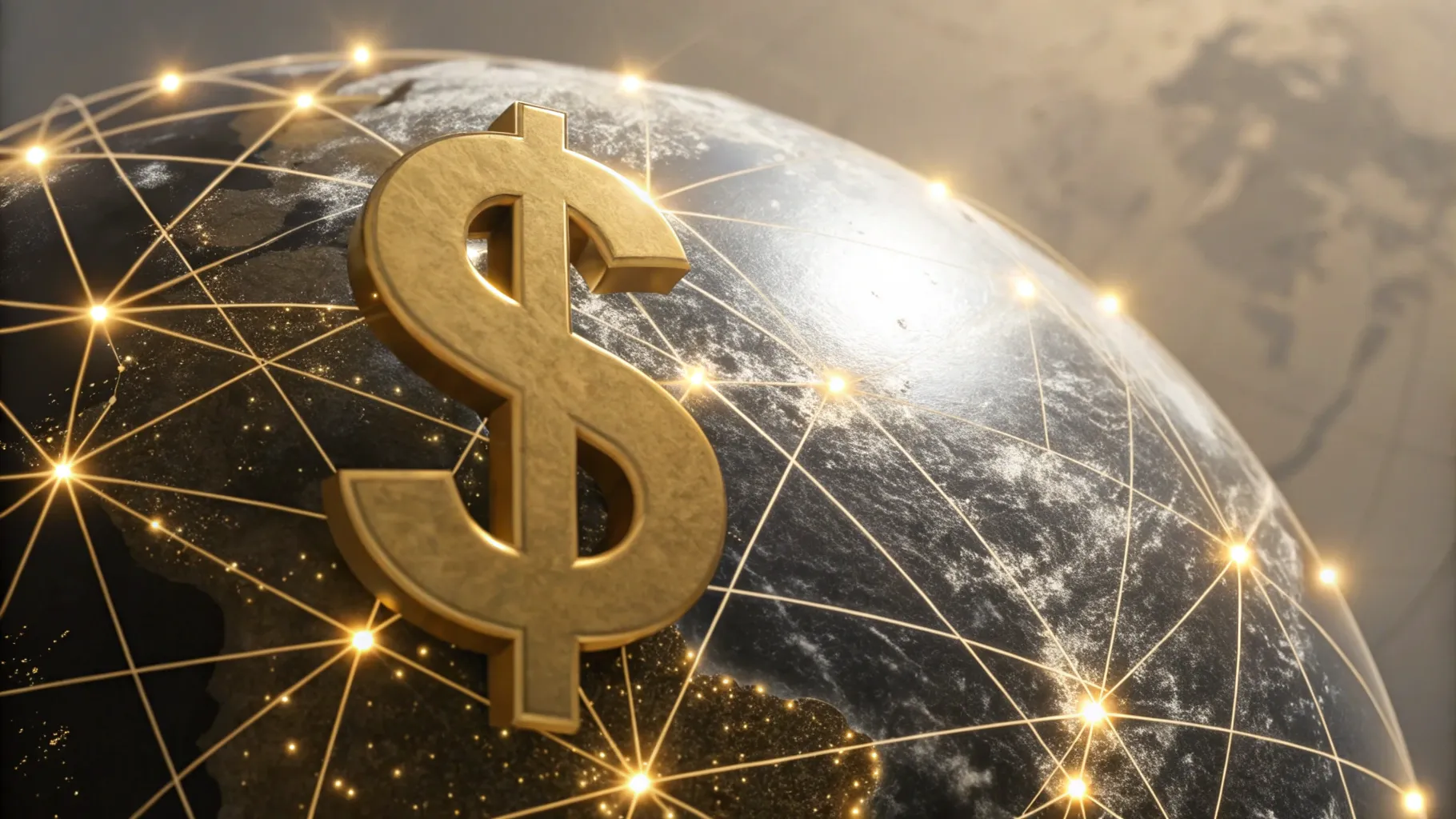Key Takeaways
- The US dollar’s dominance began with the Bretton Woods Agreement, which made it the world’s main currency.
- Its strength is kept up by powerful network effects and deep, trustworthy financial markets.
- The dollar gives the US an “exorbitant privilege” but creates risks for other nations.
- A global move toward “de-dollarization” is challenging the dollar’s top spot.
Introduction: The Dollar’s Enduring Reign
Have you ever wondered why so many major deals around the world are done in US dollars? From buying oil to settling international debts, the dollar is everywhere. Its position as the world’s main currency isn’t an accident. It’s the result of a deliberate plan and a powerful network that has grown over decades. Today, we’ll explore how the dollar rose to the top, what keeps it there, and what challenges it faces in a changing world.
The Historical Foundations of Dollar Power

The dollar’s journey to the top began after a period of global turmoil.
The Bretton Woods System (1944–1971): A Golden Start
After World War II, leaders from 44 countries met in Bretton Woods, New Hampshire, to create a new financial system. The goal was to build a stable global economy. This meeting led to the Bretton Woods Agreement, which made the US dollar the world’s main currency. At the time, the dollar was the only currency directly tied to gold, at a fixed price of $35 per ounce. The US was a natural choice to lead this system since its industrial base was untouched by the war, and it held nearly two-thirds of the world’s gold. This system made the dollar the de facto international unit of account, a role once held by the British pound.
However, the system faced a big problem known as the “Triffin Dilemma”. To provide enough dollars for growing international trade, the US had to run a balance of payments deficit. Over time, this led to a paradox: as more dollars circulated globally, the amount of foreign-held dollars began to exceed the US gold reserves. This made other countries, like France, question if the US could truly honor its promise to exchange dollars for gold. The trust in the system began to fall apart, leading to its collapse.
The Nixon Shock and the Rise of the Petrodollar
The Bretton Woods system officially ended on August 15, 1971, when President Richard Nixon stopped letting other countries convert their dollars into gold. This move, called the “Nixon Shock,” turned the dollar into a floating, or fiat, currency, meaning its value was based on the “good faith and credit” of the US government, not on a physical commodity like gold.
With its golden anchor gone, the dollar needed a new foundation. This came from a deal with Saudi Arabia, the world’s largest oil exporter. They agreed to sell their oil exclusively in US dollars. This created the petrodollar system and a powerful, self-sustaining cycle. Since all countries need oil, they had to buy US dollars to get it, creating a perpetual global demand for the US currency. Oil-exporting nations then recycled these dollars by investing them back into the US economy, often by purchasing US Treasury securities. This system made sure the dollar remained the world’s top currency for decades.
The Pillars of Current Dominance
Today, the dollar’s power isn’t based on a formal agreement, but on its deep roots in the global financial system.
Unmatched Network Effects and Global Transactions
The dollar’s strength comes from a simple idea: the more it is used, the more essential it becomes. This is a powerful network effect. The dollar is used on one side of a remarkable 88% of all global currency trades and is on one side of a vast number of transactions. It is also the currency for 54% of global trade invoices and 70% of all foreign currency debt.
This widespread use has created a level of liquidity that no other currency can match. Liquidity means an asset can be easily bought or sold without affecting its price. The US Treasury securities market, with over $22.5 trillion in outstanding debt, is the world’s leading safe place for central banks and large investors to store money. This market is so big and open that countries can buy and sell huge amounts of assets quickly and without causing major problems. This makes the dollar a “safe haven” in times of global economic turmoil, which only increases its demand.
The Bulwark of Trust: Stability and the Rule of Law
Beyond its economic power, the dollar’s dominance rests on global trust in the United States. Investors around the world trust that the US government, its legal system, and its central bank, the Federal Reserve, are stable and independent. This confidence gives foreign investors the assurance that their money will be safe from arbitrary seizure or political meddling.
The US also plays a central role in running the global financial system, including networks like the Society for Worldwide Interbank Financial Telecommunication (SWIFT). Because most international trade and payments in US dollars are ultimately handled by US banks, the US government can use its financial power to impose sanctions. By cutting off a person or country from the dollar system, the US can make it difficult for them to do international business. This power allows the US to borrow trillions of dollars from global markets at very low interest rates, which in turn helps fund the military and diplomatic efforts that project American power worldwide.
The “Exorbitant Privilege”: Benefits for the US, Costs for Others
The dollar’s top position gives the US a powerful and unique advantage.
The American Advantage
This advantage is what former French Finance Minister Valéry Giscard d’Estaing famously called the “exorbitant privilege“. The most prominent benefit is that the US can borrow money more easily and cheaply than other nations. Because there is so much demand for US government bonds, the US government does not have to offer high interest rates to attract buyers. This also allows the US to run persistent trade deficits—meaning it buys more from other countries than it sells to them—without facing a crisis, because its imports are purchased in its own currency. The US government also profits from printing money, a concept called seigniorage, since a significant portion of physical US dollar notes are held overseas.
Costs and Vulnerabilities for Other Nations
While the US benefits, other nations face significant costs and risks. They must hold large amounts of dollar reserves to pay for imports and handle financial shocks. This dependence means that many countries cannot borrow money or pay for foreign goods in their own currencies, a dynamic that can become a source of instability. A major disadvantage is their exposure to the ripple effects of US monetary policy. For example, when the US raises interest rates, it strengthens the dollar, which can cause capital outflows from emerging markets. A strengthening dollar can also make other countries’ exports more expensive and increase the cost of servicing their dollar-based debts.
The biggest risk for foreign entities is their exposure to US financial sanctions. The US’s decision to freeze Russia’s dollar and euro reserves in 2022 showed the world that holding assets in the US-dominated system comes with significant geopolitical risk. This has given countries a powerful reason to seek ways to conduct trade and manage their reserves outside of the dollar’s reach.
Challenges to the Dollar’s Rule: The De-dollarization Movement
The dollar’s dominance is now being challenged by a global push to reduce its use, a movement called de-dollarization.
The BRICS+ Alliance and the Multipolar Ambition
This movement is spearheaded by the BRICS+ alliance, which now includes Brazil, Russia, India, China, South Africa, Egypt, Ethiopia, Iran, the UAE, and Indonesia. Their core motivation is to create a “counterweight to Western influence” and to reduce their vulnerability to US financial sanctions.
The BRICS+ nations are using several specific strategies to achieve this. They are increasing trade in their own local currencies to bypass the need for dollars entirely. For instance, Russia and China now settle nearly 90% of their bilateral trade in yuan and rubles. The alliance is also building new financial institutions, such as the New Development Bank, and exploring new payment platforms like “BRICS Pay” to operate outside the SWIFT network.
However, this movement faces big challenges. The Chinese yuan, the most viable contender, lacks full convertibility and its financial markets are not as open and deep as the US markets. The alliance members also have different interests; for example, India has publicly distanced itself from the idea of a common BRICS currency.
The Renaissance of Gold: A Strategic Hedge
A more subtle challenge to the dollar is the massive and unprecedented increase in central bank gold purchases. Since 2022, central banks have bought over 1,000 tonnes of gold each year. For the first time in nearly three decades, the value of their gold holdings now exceeds their exposure to US Treasury bonds.
This trend is a direct result of geopolitical tensions. The freezing of Russian central bank reserves served as a stark warning to central bankers worldwide that holding dollar-denominated assets exposes a country to the political will of the US government. Gold, on the other hand, has no single sovereign issuer and cannot be electronically frozen by a third party, making it a “sanctions-proof” asset.
The Digital Challenge: CBDCs and New Payment Systems
New technologies, especially Central Bank Digital Currencies (CBDCs), are also emerging as a long-term challenge. These are digital versions of a country’s currency. China has been a leader in this area with its e-CNY, and it is actively using its Belt and Road projects to build digital currency rails to bypass Western banking networks and reduce the costs of international transactions.
The BRICS nations and other countries are also exploring a blockchain-based platform called Project mBridge to support real-time payments using multiple CBDCs. This system is intended to create a direct settlement network that does not rely on an intermediary US bank or the SWIFT messaging system. The US, by contrast, has been slower to develop its own CBDC, believing that the dollar’s strength is rooted in the American economy and legal protections, not the technology used to move it.
Conclusion: A Multipolar Future
The US dollar’s dominance is a strong legacy of a post-war financial system and a powerful network that is still very much in place. While the dollar’s share of global reserves has slowly declined from its peak of over 70% in the 1990s to about 58% today, a sudden “dethroning” is highly unlikely. The structural advantages that underpin its status—the sheer scale of its network effects, the unmatched depth and liquidity of US capital markets, and the fundamental trust in its legal and political institutions—are too strong to be undone quickly.
Instead, the global financial system is moving toward a more complex, multipolar arrangement. The dollar will likely remain a central pillar, but it will share its role with other major currencies, a growing amount of gold, and new, politically motivated digital payment rails. This shift will likely lead to a new era of currency volatility and greater complexity in global finance. For the US, it means a need to carefully consider how its policies affect the trust that its currency is built on. For other nations, it means a constant balancing act between seeking financial independence and dealing with a global economy still deeply reliant on the dollar.
Frequently Asked Questions (FAQs)
What is a “reserve currency”?
A reserve currency is a foreign currency that central banks and other major financial institutions hold in large amounts as part of their foreign reserves. It’s used for international trade, investment, and to manage a country’s own currency’s value. The US dollar is the world’s primary reserve currency.
What is the “Nixon Shock”?
The “Nixon Shock” refers to the events on August 15, 1971, when US President Richard Nixon ended the direct link between the US dollar and gold. This move turned the dollar into a floating currency and marked the end of the Bretton Woods system.
What is the “petrodollar system”?
The petrodollar system is a cycle that began when the US made a deal with Saudi Arabia for oil to be priced and traded only in US dollars. This created a constant global demand for the dollar, as countries needed to get dollars to buy oil, and the oil-exporting nations would then reinvest those dollars back into the US economy.
What is “de-dollarization”?
De-dollarization is a movement by countries and economic blocs to reduce their reliance on the US dollar for international trade and as a reserve currency. This is often motivated by a desire for financial independence and to avoid being vulnerable to US financial sanctions.
What are the BRICS+ countries?
The original BRICS group included Brazil, Russia, India, China, and South Africa. The “+” signifies the recent expansion of the alliance, which now includes countries like Egypt, Ethiopia, Iran, the UAE, and Indonesia. These nations are working together to increase their influence in the global economy and challenge the existing financial system.





